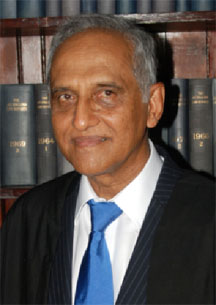Analysts Christopher Ram and Ramon Gaskin say the Amaila Falls Hydropower Project (AFHP) should be retendered internationally or scrapped entirely, while warning that the cost associated with the project is well over the country’s US$1.7 billion national debt.
“We do not reject hydro as a general proposition but this Amaila deal we have to reject it,”


Gaskin said at a joint press conference held at the Georgetown Club yesterday, citing costs, including a projected US$2.2 billion price tag over the next 20 years, a lack of transparency and deficiencies of the Guyana Power and Light Inc (GPL).
Gaskin noted that while Guyana is expected to foot 82 per cent of the US$840M project cost, Guyanese ownership will only be 40 per cent. He noted that Sithe Global, the project contractors, will invest US$150 million and will own 60 per cent of the project, while collecting a whopping 16 per cent in interest.
Gaskin also pointed out that the AFHP was originally sold as a BOOT (Build Own Operate Transfer) project but has since seemingly transformed into a venture capital agreement. “This thing has changed. This thing is not no BOOT, this is a joint venture where the people of this country are putting in 82 and getting 40 and they putting in 18 and getting 60. This is no longer a BOOT operation. So all the talk of BOOT, I would say, is a confounded lie,” Gaskin proclaimed.
He stated that to date Sithe Global has acknowledged that a project of this magnitude, producing 165 megawatts, should cost in the range of US$350 to US$400 million. Sithe Global’s Bujagali Hydroelectric Project in Uganda, which produces 250 megawatts and cost US$900 million, he noted, was 40 per cent cheaper than the AFHP.
“There has been no competitive bidding for this project. This is the largest project ever to be undertaken in this country if it should go through at US$840 million capital cost and there has been no bidding, no international tendering,” Gaskin said, while adding that the government continuously talks about the amount of money that will be saved but continuously disregards the billions that need to be paid back. He noted that in the US$2.4 billion accrued costs, the Inter-American Development Bank’s interest rate and Guyana equity were not calculated.
Gaskin noted that the cost could in fact be more, pointing out that while the project was being sold in Guyanese dollars any work needed to be done to service the project was to be done in US currency. He continued that the high exchange rate risks were very troubling. Gaskin pointed out Guyana’s current rate fluctuation on the global market and noted that uncertainty is present now much less in 20 years.
GPL
Gaskin also said that GPL will have to offset costs by adjusting tariffs annually, which is currently part of the Amaila Falls Project document. He stated that the risks associated with this were immeasurable because it will solely rely on GPL to utilise a tariff which will reflect the fluctuation. He said that at this point, while he was not a betting man he could say that the kilowatt per hour price would be significantly higher. GPL reports that the current price is $63 per kilowatt hour.
Gaskin, who is also a former GPL consultant, read from the project document. “It says it clearly that GPL should adjust tariffs annually in order to accommodate the cost associated with this project GPL will be buying power we understand it is planned,” he noted, further saying that the power purchase agreements were set at US$110 million per annum, increasing annually for the first 12 years by 1.5 per cent and US$71 million per annum over years 13 to 20.
He said that the increase in tariffs is not the only concern. “GPL as presently configured cannot handle this project to take power from Amaila, if Amaila were to be built, because we are talking about an entirely inefficient system with line losses, system losses, a dilapidated system,” he noted. He said too that the current contract does not require GPL to do any progressive work with the grid, instead “the contract requires GPL to fix the system… at the point where you take the power. You got to get that right. What you do with that afterwards is your business.”
Gaskin stated that for every 100 kilowatt per hour purchased by GPL, they could only feasibly sell 68 kilowatts because of current system limitations. He said that GPL, which currently operates at 31 per cent complete system losses, is also projected to suffer a shortfall of US$9.4 million in 2016, the same year Amaila is expected to start operations.
He stated that the government was operating under “assumptions” that the AFHP would entice self generators such as Banks DIH, DDL and Gafoors Complex to come back onto the grid, However Gaskin revealed that there was no basis for this. He said plainly that self generators operate with continuous power and would not risk blackouts and interruption of production, which he said the AFHP did not guarantee against.
Instead, Gaskin noted, that “in this document Amaila can give you blackout six different ways, legally, contractually, the government signed to it.” He said that inadequate water flow could result in a shutdown as well as scheduled shutdowns which would last 10 days to facilitate maintenance.
Lack of
documentation
Meanwhile, Ram stated that while GPL has some form of provisions, there is no formal stakeholders’ agreement and as a result there is mass confusion in relation to debt and loans. “These documents recognise the existence of a shareholder agreement but there is no shareholder agreement in this. We don’t know to what extent this government has sold out,” Ram stated. He added that until a shareholders’ agreement was established, the cost could only be estimated and without one there was no clarity on whether Sithe Global would receive its US$150 million investment.
“We are not even sure who the borrower is because it is compounded by this uncertainty over this piece of legislation,” he said, referring to the motion by government to increase the debt ceiling, which the joint opposition voted down in the National Assembly on Thursday last week.
He added that the agreement with the China Development Bank assured that Guyana was responsible for an 8.5 per cent interest rate. He compared that with the IDB’s one per cent interest rate per annum in the first 10 years and the two per cent for the additional 30 years. Ram noted that not only was the China Development Bank receiving 8.5 per cent interest, but Guyana was responsible for lender fees over US$33 million and death risk insurance at US$57 million.
Ram noted that the AFHP was currently in breach of the Hydroelectric Act and the constitution, with Sithe Global instituting a clause preventing Guyanese from accessing land up to 42 miles away from the site. Ram noted that clarity was significantly diminished in that the project document did not outline what was meant by 42 miles. He noted that the documents available did a poor job of outlining what the targets were but that the penalties for breaching the agreement were explicit and harsh.
“We don’t have the project description. We don’t have the EPA, that’s schedule one, schedule two, schedule nine, we don’t have schedule 10, [and] we don’t have operations and maintenance terms. None of these things is there we don’t even know…what is the land description and maps,” Ram said, while noting that the government was taking a huge risk because defaulting would result in serious penalties and going back to the drawing board is the only option for the AFHP.
The government and its allies have kept up a flurry of attacks on the opposition over the defeat of the Amaila measures. The government yesterday announced that it is convening a stakeholders’ forum today at the International Conference Centre to consider the matter.





